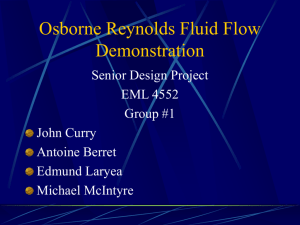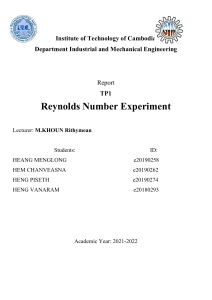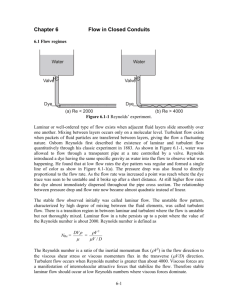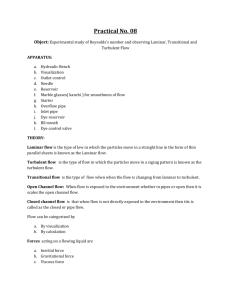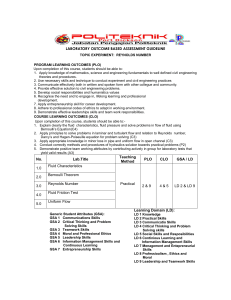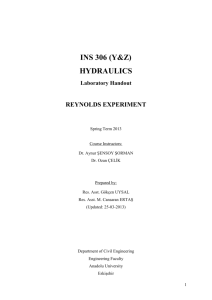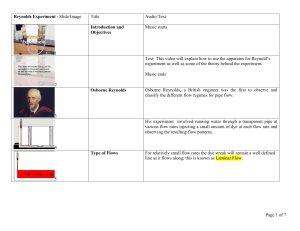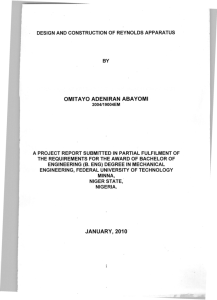Reynolds experiment the nature of turbulence.
advertisement
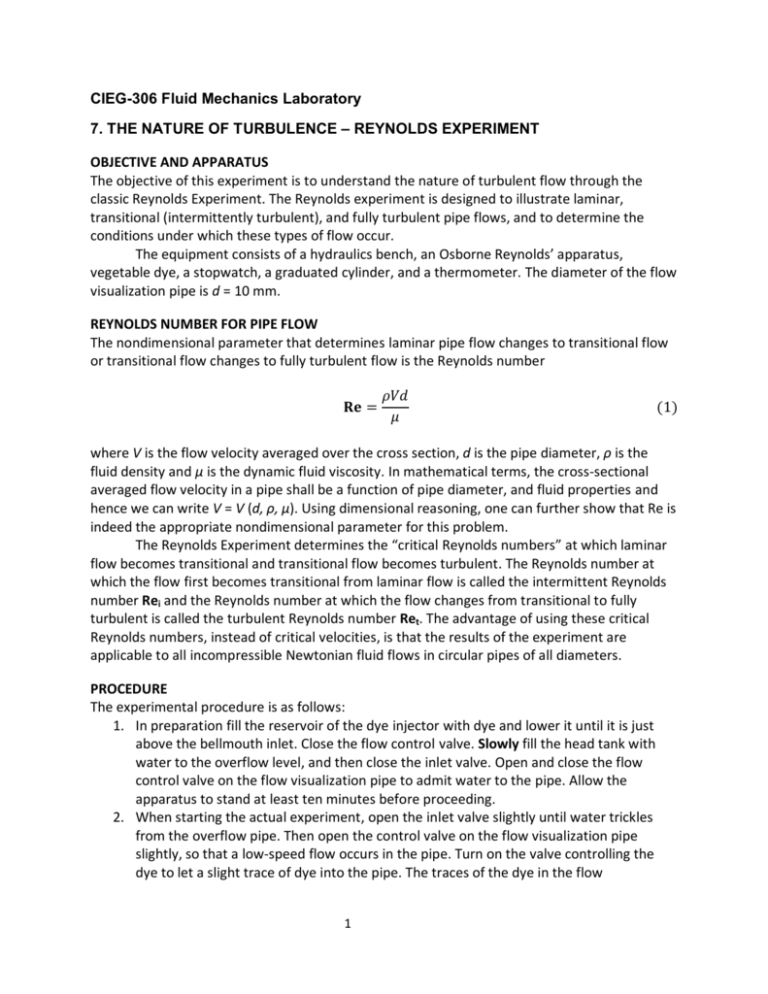
CIEG-306 Fluid Mechanics Laboratory 7. THE NATURE OF TURBULENCE – REYNOLDS EXPERIMENT OBJECTIVE AND APPARATUS The objective of this experiment is to understand the nature of turbulent flow through the classic Reynolds Experiment. The Reynolds experiment is designed to illustrate laminar, transitional (intermittently turbulent), and fully turbulent pipe flows, and to determine the conditions under which these types of flow occur. The equipment consists of a hydraulics bench, an Osborne Reynolds’ apparatus, vegetable dye, a stopwatch, a graduated cylinder, and a thermometer. The diameter of the flow visualization pipe is d = 10 mm. REYNOLDS NUMBER FOR PIPE FLOW The nondimensional parameter that determines laminar pipe flow changes to transitional flow or transitional flow changes to fully turbulent flow is the Reynolds number 𝐑𝐞 = 𝜌𝑉𝑑 𝜇 (1) where V is the flow velocity averaged over the cross section, d is the pipe diameter, ρ is the fluid density and μ is the dynamic fluid viscosity. In mathematical terms, the cross-sectional averaged flow velocity in a pipe shall be a function of pipe diameter, and fluid properties and hence we can write V = V (d, ρ, μ). Using dimensional reasoning, one can further show that Re is indeed the appropriate nondimensional parameter for this problem. The Reynolds Experiment determines the “critical Reynolds numbers” at which laminar flow becomes transitional and transitional flow becomes turbulent. The Reynolds number at which the flow first becomes transitional from laminar flow is called the intermittent Reynolds number Rei and the Reynolds number at which the flow changes from transitional to fully turbulent is called the turbulent Reynolds number Ret. The advantage of using these critical Reynolds numbers, instead of critical velocities, is that the results of the experiment are applicable to all incompressible Newtonian fluid flows in circular pipes of all diameters. PROCEDURE The experimental procedure is as follows: 1. In preparation fill the reservoir of the dye injector with dye and lower it until it is just above the bellmouth inlet. Close the flow control valve. Slowly fill the head tank with water to the overflow level, and then close the inlet valve. Open and close the flow control valve on the flow visualization pipe to admit water to the pipe. Allow the apparatus to stand at least ten minutes before proceeding. 2. When starting the actual experiment, open the inlet valve slightly until water trickles from the overflow pipe. Then open the control valve on the flow visualization pipe slightly, so that a low-speed flow occurs in the pipe. Turn on the valve controlling the dye to let a slight trace of dye into the pipe. The traces of the dye in the flow 1 visualization pipe illustrate the character of the flow. Initially, the dye should remain in a steady, narrow stream, indicating laminar flow. 3. We then open the control valve in small increments, so that the flow speed gradually increases. At a certain flow speed, the flow becomes transitional (the flow features visualized via the dye become different). This represents the first stage at which measurements are taken and the velocity corresponds to Rei. 4. If the flow rate is further increased, the flow will finally reach a fully turbulent state (flow features are again becoming different). The change to fully turbulent flow is the second stage at which measurements are taken (corresponding to Ret). 5. You must collect the water discharging from the flow visualization pipe in the graduated cylinder. Record the time required to collect it, so that the volume flux per second can be calculated. Record the nature of the flow. Also record the water temperature. Repeat the procedure so that you have at least two sets of data for laminar, transitional, and turbulent flow states. DATA ANALYSIS AND DISCUSSION Use the continuity equation for incompressible flows to determine the average velocity V from the measurements. If A = cross-sectional area of the pipe, Vol = volume of water collected, and t = time required to collect it, then show that 𝑉= 𝑉𝑜𝑙 𝐴𝑡 (2) To determine the density and viscosity of the water, use the measured temperature in tables available in your fluid mechanics textbook. The theoretical background section of your report should contain a discussion of the derivation of Equation (1) from dimensional reasoning (consult your fluid textbook under the title ‘dimensional analysis’). Your results should include, in tabular form, measurements of volume, time and fluid temperature, computed velocity and Reynolds number, and a description with illustrative sketches of the flow characteristics for each experimental run. Discuss your observation and compare it with that described in the textbook. 2

